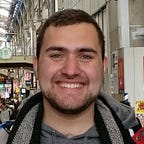Flying with a Mission — Taking Model Aircraft to the Next Level
If you are passionate about flying or building things that fly, then read on! This post is about my involvement in the student design team called Design Build and Fly, at the University of Florida, and hopefully will motivate you to join your local team.
Every year, universities around the world get together and compete in the largest custom-made RC plane championship. The challenges change from year to year, but it can be summarized in a single sentence
Fly like no one has, in order to take off like no one could
The content is structured as follows:
- The Competition
- Mission for 2018
- Our Approach
- Designing — Prototyping — Testing
- Final Design
- Read on! A list of our official reports and documents.
The Competition
Design-Build and Fly (DBF) is an annual competition where universities around the world design, build and compete with their student-made remote-controlled aircrafts fulfilling mission requirements.
I was a member of the DBF team at the University of Florida since it was established in 2015. For the 2018 competition, I served as the Aerodynamics Lead for the team, where I analyzed aircraft design, stability, and control for the year’s mission.
Mission for 2018
The score for the DBF competition is calculated based on the completion of three main missions, while factors such as weight and wingspan affect the overall score. For this year the mission was based on designing an aircraft capable of carrying “passengers” (represented by bouncy balls of varying sizes) and “payload” (represented by blocks of foam with given dimensions). The airplane was to complete three in-flight missions following a 2500ft round-trip circuit, see below.
For each mission, there are significant trade-offs that needed to be analyzed in order to achieve the highest possible score. The mission requirements for the year 2018 were:
Mission 1: Complete three laps on the circuit without passengers or payload.
- Teams achieved a full score upon completion of three laps within a 5-minute window.
Mission 2: Complete three laps of the circuit carrying a maximum number of passengers.
- The score for this mission was calculated based on a maximum number of passengers carried while completing three laps around the circuit. The more passengers, the higher the score.
Mission 3: Endurance. The long haul of passengers and payload
- The score for this mission is calculated based on the maximum amount of payload carried and the number of laps flown around the circuit. The longer a team flies, the higher the score they’ll achieve.
Ground mission: Ability to remove and replace two arbitrarily selected aircraft components
- Pass/fail mission where teams are required to change two components of the aircraft (landing gear, servo, tail, etc.) within a window of 3 minutes.
In addition to the four missions outlined above, the overall score for each team was divided by the rated aircraft cost (RAC), which is the product of the overall wingspan in inches and empty weight of the plane in ounces.
RAC = Empty Weight (Oz) * Wingspan (inches)
UF — DBF Approach
Understanding the mission requirements, and the significant trade-offs implied in obtaining the highest possible score, our team determined that the best outcome would be obtained by minimizing the rated aircraft cost (RAC). This meant that our plane would be made to fly with the minimum possible number of passengers, and the smallest possible wingspan.
Design Phase — Prototyping phase — Testing Phase
Design
Factors affecting the design of the aircraft such as wing structure, fuselage type, and material selection were analyzed using a decision matrix and the optimal configuration was selected. An optimization algorithm was employed to select the ideal wingspan that would withstand flight while minimizing the overall score.
Ultimately, a carbon-fiber flying wing design was selected as the best option for the 2018 competition.
Prototyping
Once the preliminary design was selected, prototyping was performed to identify the optimal design. Several wooden molds were machined to build the carbon-fiber wings and fuselage.
In addition, carbon fiber was laid-up on a bi-directional pattern in order to increase strength, while accounting for wing deflection.
Testing
Once the prototypes were built, aerodynamic and structural testing was performed to identify aircraft characteristics, risk factors, areas of improvement, and successful design implementation.
Wind tunnel testing was used to determine the lift and drag coefficients of the fuselage and the main wing.
Propeller thrust testing was performed to determine propeller sizing and battery draw rates for different propulsion systems.
Final Construction and Flight
The final design can be seen below:
And finally, the final plane at the 2018 Design Build and Fly competition held in Wichita, Kansas!
Check out our reports
Afterthought:
This post took me 3 pomodoros to complete. If you also want to increase your productivity and learn how to build a pomodoro timer using python, read my other post here:
